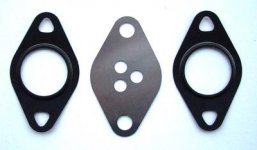When combustion temperatures exceed 2500 degree F, atmospheric nitrogen begins to react with oxygen during combustion. The result is various compounds called nitrogen oxides (NOX), which play a major role in urban air pollution. To reduce the formation of NOX, combustion temperatures must be kept below the NOX threshold. This is done by recirculating a small amount of exhaust through the "exhaust gas recirculation," or EGR. valve.
The EGR valve controls a small passageway between the intake and exhaust manifolds. When the valve opens, intake vacuum draws exhaust through the valve. This dilutes the incoming air/fuel mixture and has a quenching effect on combustion temperatures which keeps NOX within acceptable limits. As an added benefit, it also reduces the engine's octane requirements which lessens the danger of detonation



